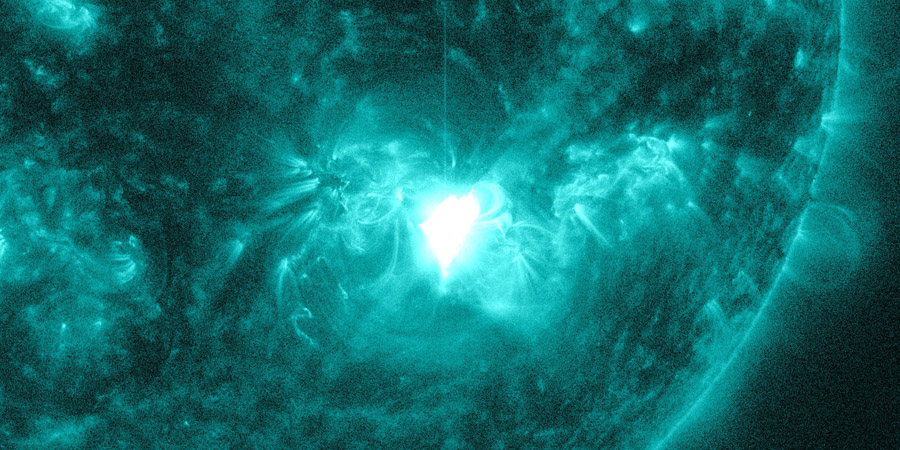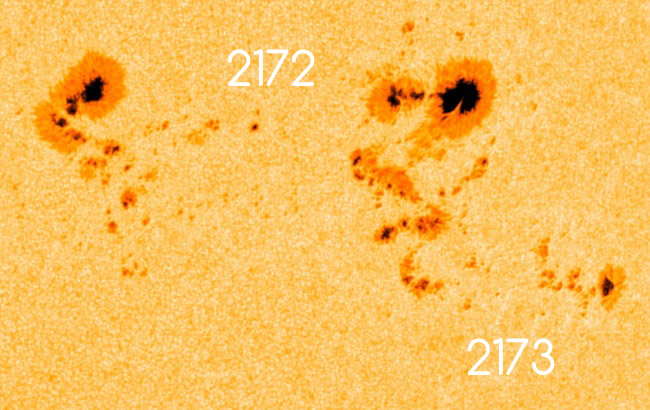M5.1+M1.0 solar flares from sunspot regions 2172+2173
Sunday, 28 September 2014 07:40 UTC

We talked yesterday about how close together sunspot regions 2172 and 2173 are and that they might interact with each other. Well, they did not disappoint! Both sunspot regions worked together to produce an M5.1 solar flare (R2-moderate radio blackout) that peaked at 02:58 UTC on 28 September.

The image above from NASA SDO in the 1600 Ångström wavelength shows very well that this solar flare is a cooperation between both sunspot regions 2172 and 2173.
Coronagraph imagery from SOHO are still unavailable but SDO imagery suggests that a coronal mass ejection was likely launched. It looks however to be heading mostly south-west and away from Earth as we can see on the image below which shows some coronal dimming, but it does not look all that spectaculair. This post will be updated later today when we can provide more information regarding the coronal mass ejection.

Images: NASA SDO / SIDC.
NOAA SWPC alerts
ALERT: X-Ray Flux exceeded M5 Threshold Reached: 2014 Sep 28 0258 UTC NOAA Scale: R2 - Moderate
ALERT: Type II Radio Emission Begin Time: 2014 Sep 28 0245 UTC Estimated Velocity: 638 km/s
ALERT: Type IV Radio Emission Begin Time: 2014 Sep 28 0311 UTC
SUMMARY: 10cm Radio Burst Begin Time: 2014 Sep 28 0243 UTC Maximum Time: 2014 Sep 28 0247 UTC End Time: 2014 Sep 28 0248 UTC Duration: 5 minutes Peak Flux: 220 sfu Latest Penticton Noon Flux: 181 sfu
SUMMARY: X-ray Event exceeded M5 Begin Time: 2014 Sep 28 0239 UTC Maximum Time: 2014 Sep 28 0258 UTC End Time: 2014 Sep 28 0319 UTC X-ray Class: M5.1 Optical Class: 2b Location: S13W23 NOAA Scale: R2 - Moderate
Coronal mass ejection (ADDED 17:00 UTC)
Coronagraph imagery from SOHO/LASCO is now available and show that the M5.1 solar flare launched a slow and narrow coronal mass ejection off the south-west limb. This coronal mass ejection is unfortunately not earth-directed.

Image: NASA/ESA SOHO.
M1 solar flare (ADDED 20:30 UTC)
Sunspot regions 2172 and 2173 are now really starting to merge together and around 17:30 UTC they produced an M1 solar flare. Imagery suggests again that a coronal mass ejection could have been launched but it will likely again be directed away from Earth in a similar way as the coronal mass ejection from the M5.1 solar flare. More M-class flares are possible in the hours ahead with a slight chance on an X-class event.



Sunspot region 2175 (ADDED 20:48 UTC)
Quick look at another sunspot group of interest: sunspot region 2175 remains quiet today but has a strong delta sunspot and still has the potential to produce an M-class event. Even an X-class event can not be excluded but the chances are low for such a strong solar flare. Keep your eye on the X-ray flux as more fireworks are likely!


Follow us on Twitter for real-time alerts.
Images: NASA SDO.
Thank you for reading this article! Did you have any trouble with the technical terms used in this article? Our help section is the place to be where you can find in-depth articles, a FAQ and a list with common abbreviations. Still puzzled? Just post on our forum where we will help you the best we can!
Latest news
Latest forum messages
Support SpaceWeatherLive.com!
A lot of people come to SpaceWeatherLive to follow the Sun's activity or if there is aurora to be seen, but with more traffic comes higher server costs. Consider a donation if you enjoy SpaceWeatherLive so we can keep the website online!

Space weather facts
| Last X-flare | 2024/12/08 | X2.2 |
| Last M-flare | 2024/12/23 | M8.9 |
| Last geomagnetic storm | 2024/12/17 | Kp5+ (G1) |
| Spotless days | |
|---|---|
| Last spotless day | 2022/06/08 |
| Monthly mean Sunspot Number | |
|---|---|
| November 2024 | 152.5 -13.9 |
| December 2024 | 106.6 -45.9 |
| Last 30 days | 116.1 -41.8 |


